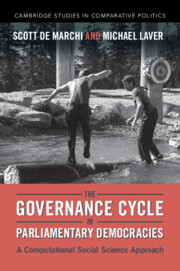Book contents
- The Governance Cycle in Parliamentary Democracies
- Cambridge Studies in Comparative Politics
- The Governance Cycle in Parliamentary Democracies
- Copyright page
- Contents
- Figures
- Tables
- Acknowledgments
- Introduction
- 1 Governance, Complexity, Computation, and Rationality
- 2 The Governance Cycle
- 3 An Agent-Based Model of Government Formation and Survival
- 4 Artificial Intelligence and Government Formation
- 5 Analyzing Models of Government Formation and Survival
- 6 Empirical Analyses of Government Formation and Stability
- 7 Conclusions and Aspirations
- Book part
- References
- Index
- Cambridge Studies in Comparative Politics
3 - An Agent-Based Model of Government Formation and Survival
Published online by Cambridge University Press: 02 February 2023
- The Governance Cycle in Parliamentary Democracies
- Cambridge Studies in Comparative Politics
- The Governance Cycle in Parliamentary Democracies
- Copyright page
- Contents
- Figures
- Tables
- Acknowledgments
- Introduction
- 1 Governance, Complexity, Computation, and Rationality
- 2 The Governance Cycle
- 3 An Agent-Based Model of Government Formation and Survival
- 4 Artificial Intelligence and Government Formation
- 5 Analyzing Models of Government Formation and Survival
- 6 Empirical Analyses of Government Formation and Stability
- 7 Conclusions and Aspirations
- Book part
- References
- Index
- Cambridge Studies in Comparative Politics
Summary
We build an agent-based model (ABM) of how senior politicians navigate the complex governance cycle using relatively simple heuristics. They first test whether they can form a single party minority government. If not, they seek coalition partners and negotiate with these. They treat “Gamson’s Law” – government parties get perks payoffs in proportion to their seat shares – as common knowledge. When different politicians attach different importance to the same issue, "logrolling" allows them to realize gains from trade and agree a joint policy position even when they have divergent policy preferences. We allow for the realistic possibility that multiple proposals for government are under consideration at the same time. Nonetheless, there may often be a “Condorcet winner” among the set of proposals, which beats all others in pairwise comparisons. Finally, we specify a model of government survival, which assumes incumbent governments are subject to a stream of unbiased random shocks which may perturb model parameters so much that legislators now prefer some alternative to the incumbent. For any given government, our model allows us to estimate the probability of this happening.
Keywords
- Type
- Chapter
- Information
- The Governance Cycle in Parliamentary DemocraciesA Computational Social Science Approach, pp. 60 - 82Publisher: Cambridge University PressPrint publication year: 2023



